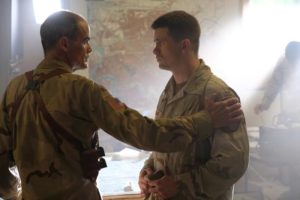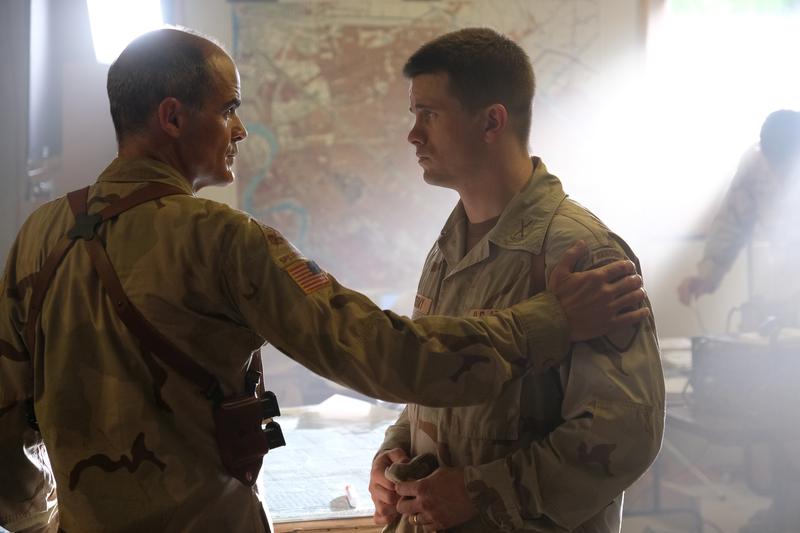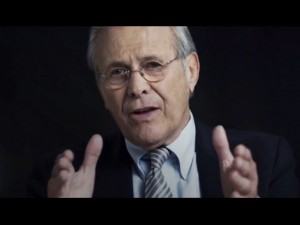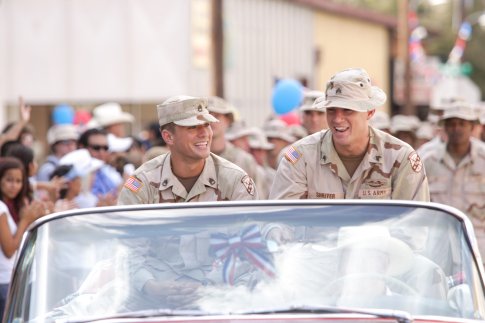Martha Raddatz on National Geographic’s “The Long Road Home”
Posted on November 9, 2017 at 4:58 pm

National Geographic’s new series “The Long Road Home” is based on the best-selling book by journalist Martha Raddatz about soldiers sent to Iraq on a peacekeeping mission in 2004 who were ambushed on a day that came to be known as “Black Sunday.” The series is powerful, inspiring, and deeply moving as it lets us into the lives of those who were there and their families. In an interview, Raddatz talked about how she got the story, what she learned, and what she hopes the series, premiering as we prepare to observe Veterans’ Day, will teach us about the people who risk their lives — and give their lives — for our freedom and for each other.
The news footage from Vietnam on the news every night played a significant role in eroding the support for the war. We do not see that kind of coverage of what our troops are doing in Iraq and Afghanistan.
We did in the beginning. It was it was on all the time and take it from me because I was covering it. But it hasn’t been more recently and never in this way, in the way we tell this story about U.S. soldiers and their families and particularly families. It’s a really realistic, really raw, really warts and all, very nuanced look at war, if you can imagine nuanced war, this has got it.
What does nuance mean when you’re talking about war?
These aren’t a bunch of action figures. There is lots of breaking down doors and things like that. But they’re also very distinct people, regular people, real people. These are not Navy SEALs. These are not elite forces. These are soldiers who went over there thinking they were involved in a peacekeeping mission and found themselves ambushed and the other men in the battalion who reached out to rescue them in whatever vehicles they could find. Some of them are still serving on active duty, and I can’t remember a time when a series has portrayed soldiers still on active duty.
Was that an impediment to you in reporting on the story? Were there a lot of restrictions on what the soldiers were allowed to talk about?
They shared everything they possibly could with me. And one of the most remarkable things about this series is that the Army gave it its blessing and cooperated with us. They allowed us to shoot on base and build a 12 acre set with 85 buildings.
I think in so many ways right now Americans are ready to see this. And the Army is ready to see this. The Army is ready to say, “This is what we did and this is how we fought. This is where we went into places where we were totally unprepared for what was to come.” They saw everything before we shot it, including scenes with anti-war protesters. There’s an entire episode about a soldier who became a very outspoken war protester. So that is the kind of eye-opening experience you have with this series.
We see very clearly in the series that this is a war that’s being fought in the streets and in people’s homes.
It’s about as hand to hand combat as you can get. You look each other in the eye. There are some remarkably intimate scenes with soldiers facing down an enemy.
What have you learned about courage through reporting and telling this story?
Sometimes the people who are most courageous are the ones you never expect to be. You cannot predict it. But I also learned that courage is defined in different ways. It’s not always the ways you think. When we walk into a situation sometimes it takes a little while to find the courage to find that leadership or to find that bravery that keeps them going. Everyone finds it in a different way. And again some people don’t. And that’s the kind of broad spectrum you have.
Why was it important for you to talk to the families as well as the soldiers who were directly involved?
It’s the soldiers who told me to go talk to family because they said, “If you think it’s bad for us you should see the families and what they went through and what they have to experience and just not knowing.” The soldiers know what’s happening; they know what’s coming next. Those families just have to wait and their courage and their bravery every day, starting with that day of the ambush and years that follow this unit is I think really eye-opening for people. One of the wives would not drive into the garage behind the house without driving by the front of her house first just to make sure there was not a car up there that was going to notify her of her husband’s death.
Your work has been in television. What could you do in a book and now in a series re-creating the events that you cannot do in television news?
When I first began reporting on the story, we never had was any video. From the descriptions from the soldiers and the survivors of that battle we can see it come to life in the miniseries. It is the first time I’ve seen that come alive.
What is it that you want people to talk about with their families after they watch this show?
I want people to talk about the cost of war and to understand what it means to go to war. I want people to think about their responsibility to be informed and to have a voice to vote to do whatever it is that involves them in those life and death choices because fewer than one percent of our country serves in the military. Ninety nine percent do not. And the very least people who do not serve can do is understand the consequences.



 A young soldier who has come home from Iraq is forced to rethink his ideas about heroism and patriotism when he is “stop-lossed” — informed that instead of leaving the Army he has been involuntarily assigned to another tour of duty. Brandon (Ryan Phillippe) and Steve (Channing Tatum), his best friend since high school, were greeted with an old-fashioned hero’s welcome right out of a Norman Rockwell painting, with a parade and a warm handshake from their Senator, who says his door will always be open to real-life American heroes. They speak proudly about “killing ’em in Iraq so we won’t have to kill ’em in Texas.” But when Brandon finds out that the government has the right to send him back, he goes AWOL and leaves for Washington with Steve’s estranged fiancée (Abbie Cornish), hoping the Senator will find a way for him to stay home.
A young soldier who has come home from Iraq is forced to rethink his ideas about heroism and patriotism when he is “stop-lossed” — informed that instead of leaving the Army he has been involuntarily assigned to another tour of duty. Brandon (Ryan Phillippe) and Steve (Channing Tatum), his best friend since high school, were greeted with an old-fashioned hero’s welcome right out of a Norman Rockwell painting, with a parade and a warm handshake from their Senator, who says his door will always be open to real-life American heroes. They speak proudly about “killing ’em in Iraq so we won’t have to kill ’em in Texas.” But when Brandon finds out that the government has the right to send him back, he goes AWOL and leaves for Washington with Steve’s estranged fiancée (Abbie Cornish), hoping the Senator will find a way for him to stay home.